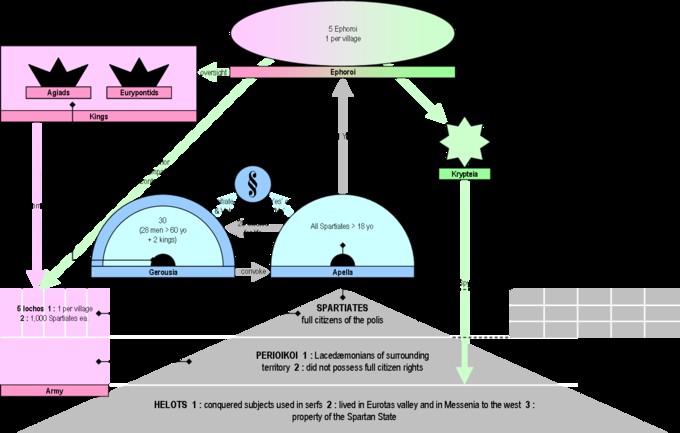How Did Training In Sparta Compare To Other City-states? COMPARE.EDU.VN explores the rigorous Spartan education system, contrasting it with the training methods prevalent in other ancient Greek city-states. Discover the unique approach to military and civic development that set Sparta apart, with in-depth analysis of Spartan discipline, citizenship, and the Helot system, crucial for understanding ancient military education. We will explore alternate training methodologies, civic duties, and enslaved populations.
1. Introduction: Contrasting Spartan Education with Other Greek City-States
Sparta, a prominent city-state in ancient Greece, was renowned for its unique and rigorous system of training and education, primarily focused on military excellence. The Spartan approach differed significantly from other city-states like Athens, Corinth, and Thebes, each with its own values, priorities, and methods of preparing its citizens. Understanding these differences sheds light on the distinctive character of Sparta and its impact on Greek history.
This analysis aims to provide a comprehensive comparison of the training methods in Sparta versus those in other Greek city-states. We will explore the core values that shaped these systems, the specific types of training imparted to young citizens, and the ultimate goals of education in each context. By examining these aspects, we can gain insights into how Sparta cultivated its formidable military prowess and how other city-states pursued their own paths to civic and cultural development.
2. Spartan Training: A Ruthless Focus on Military Prowess
The Spartan education system, known as the Agoge, was a state-sponsored program designed to mold young boys into disciplined warriors. Beginning at the age of seven, boys were removed from their families and placed into communal barracks, where they underwent rigorous physical and military training. The emphasis was on developing strength, endurance, and combat skills, as well as fostering loyalty and obedience to the state.
 Spartan warrior training
Spartan warrior training
2.1. The Agoge: Hardship and Discipline
Life in the Agoge was intentionally harsh. Boys were subjected to strict discipline, limited food rations, and minimal clothing, all aimed at toughening them physically and mentally. They were taught to endure pain, withstand hunger, and survive in challenging conditions. Military drills and exercises were a daily routine, including running, wrestling, and combat with spears and swords.
2.2. Emphasis on Stealth and Survival
In addition to physical training, Spartan boys were taught survival skills, such as foraging for food and building shelters. They were also encouraged to develop stealth and cunning, often participating in exercises that involved stealing food or evading capture. These skills were essential for effective military operations and survival in enemy territory.
2.3. Loyalty and Obedience to the State
A central aspect of Spartan training was instilling unwavering loyalty and obedience to the state. Boys were taught to prioritize the needs of Sparta above all else, including their own personal desires and ambitions. This sense of collective identity and devotion to the state was a key factor in the cohesion and effectiveness of the Spartan army.
3. Athenian Education: Cultivating the Mind and Body
In contrast to Sparta’s singular focus on military training, Athens emphasized a more well-rounded education that aimed to cultivate both the mind and body. Athenian education was not state-sponsored but rather the responsibility of individual families, allowing for greater diversity in curriculum and approach.
3.1. Gymnasium and Didaskaleion: Physical and Intellectual Development
Athenian boys typically began their education at the age of seven, attending a didaskaleion (school) where they learned reading, writing, and arithmetic. They also studied poetry, music, and drama, fostering an appreciation for the arts and literature. Physical training took place in the gymnasium, where boys engaged in sports such as running, wrestling, and javelin throwing.
3.2. Emphasis on Rhetoric and Public Speaking
A key component of Athenian education was rhetoric, the art of persuasive speaking. Athenian citizens were expected to participate actively in public life, and the ability to articulate their ideas effectively was highly valued. Boys were trained in argumentation, debate, and public speaking, preparing them for roles in politics and law.
3.3. The Role of Philosophy and Critical Thinking
Athenian education also emphasized philosophy and critical thinking. Students were encouraged to question assumptions, analyze arguments, and develop their own independent viewpoints. This intellectual freedom fostered creativity and innovation, contributing to Athens’ reputation as a center of learning and culture.
4. Comparing Military Training Philosophies
The fundamental difference between Spartan and Athenian education lies in their differing priorities. Sparta aimed to create a society of warriors, while Athens sought to cultivate well-rounded citizens capable of contributing to all aspects of civic life.
4.1. Military Focus vs. Holistic Development
Spartan training was almost exclusively focused on military skills and physical conditioning. The Agoge was designed to produce soldiers who were tough, disciplined, and fiercely loyal to the state. In contrast, Athenian education sought to develop a broader range of skills and knowledge, including intellectual, artistic, and athletic abilities.
4.2. State Control vs. Individual Choice
The Spartan education system was state-controlled, with all boys undergoing the same rigorous training. In Athens, education was the responsibility of individual families, allowing for greater diversity in curriculum and approach. This difference reflects the contrasting values of the two city-states, with Sparta prioritizing the collective good and Athens valuing individual freedom.
4.3. Outcome: Warriors vs. Citizens
The Spartan system produced highly skilled and disciplined warriors, but at the expense of intellectual and artistic development. The Athenian system cultivated well-rounded citizens capable of participating in politics, law, and the arts, but may have lacked the military prowess of Sparta.
5. Other City-States: Varied Approaches to Education and Training
While Sparta and Athens represent two contrasting models, other Greek city-states adopted a range of approaches to education and training, each tailored to their specific needs and values.
5.1. Theban Military Education
Thebes, like Sparta, placed a strong emphasis on military training, but their approach was less rigid and more focused on individual skill development. Theban military education included a mix of physical training, weapons instruction, and tactical exercises, with an emphasis on creating versatile and adaptable soldiers.
5.2. Corinthian Commercial and Naval Training
Corinth, a major commercial center, prioritized practical skills and knowledge related to trade and seafaring. Corinthian education included training in navigation, shipbuilding, and business management, preparing young citizens for careers in commerce and maritime affairs.
5.3. The Broader Greek Educational Landscape
Across the Greek world, education varied widely depending on the city-state, social class, and individual family. Some city-states emphasized physical training, while others focused on intellectual pursuits. The common thread was a commitment to preparing young citizens for their roles in society, whether as soldiers, merchants, or political leaders.
6. The Role of Women in Education
The education of women differed significantly across the Greek city-states, reflecting varying attitudes toward gender roles and the status of women in society.
6.1. Spartan Women: Physical Fitness and Independence
In Sparta, women received a unique education that emphasized physical fitness and independence. Spartan girls underwent rigorous physical training, including running, wrestling, and javelin throwing, aimed at producing strong and healthy mothers. They also enjoyed greater freedom and autonomy compared to women in other Greek city-states.
6.2. Athenian Women: Domestic Skills and Limited Education
In Athens, women’s education was primarily focused on domestic skills such as weaving, spinning, and household management. Athenian women received limited formal education and were largely confined to the home, with little participation in public life.
6.3. Contrasting Roles and Expectations
The contrasting education of women in Sparta and Athens reflects the differing roles and expectations placed upon them. Spartan women were expected to be strong and independent, capable of managing households and raising healthy children, while Athenian women were primarily valued for their domestic skills and their ability to produce legitimate heirs.
7. The Impact of Social Structure on Training
The social structure of each city-state significantly influenced the nature of training and education.
7.1. Spartan Class System: Spartiates, Perioeci, and Helots
Spartan society was divided into three main classes: Spartiates (full citizens), Perioeci (free non-citizens), and Helots (state-owned serfs). Only Spartiates underwent the rigorous Agoge, while Perioeci were typically engaged in commerce and industry, and Helots were relegated to agricultural labor. This rigid class system shaped the purpose and content of education for each group.
7.2. Athenian Democracy: Education for Citizenship
Athenian society, with its democratic ideals, placed a greater emphasis on education for all citizens, regardless of social class. While wealthy families could afford private tutors and advanced education, even poorer citizens had access to basic schooling and could participate in public life.
7.3. Slavery and Education
In both Sparta and Athens, slavery played a significant role in the economy and social structure. Slaves received no formal education and were excluded from the rights and privileges of citizenship. Their labor freed up citizens to pursue education and training, but also created a system of inequality and oppression.
8. The Lasting Legacy of Spartan and Athenian Education
The contrasting systems of education in Sparta and Athens have had a lasting impact on Western civilization, shaping our ideas about military training, civic education, and the role of the individual in society.
8.1. Spartan Model: Military Discipline and Patriotism
The Spartan model of military discipline and patriotism has been admired and emulated throughout history, influencing military training methods and inspiring a sense of national pride. However, its emphasis on conformity and suppression of individual expression has also been criticized.
8.2. Athenian Model: Intellectual Freedom and Civic Engagement
The Athenian model of intellectual freedom and civic engagement has been a cornerstone of Western democracy, promoting critical thinking, creativity, and active participation in public life. However, its exclusion of women and slaves from full citizenship has also been a subject of debate and reform.
8.3. Influence on Modern Education
Both the Spartan and Athenian models have influenced modern education systems, with debates continuing over the balance between vocational training and liberal arts education, and the role of the state in shaping the minds of young citizens.
9. Conclusion: Diverse Paths to Excellence
In conclusion, the training and education systems in Sparta and other Greek city-states reflect their diverse values, priorities, and social structures. While Sparta focused on military excellence and state loyalty, Athens emphasized intellectual freedom and civic engagement. Other city-states adopted a range of approaches, each tailored to their specific needs and circumstances. By understanding these differences, we can gain a deeper appreciation for the richness and complexity of ancient Greek civilization.
Navigating the complexities of comparing different educational approaches can be challenging. At COMPARE.EDU.VN, we provide comprehensive and objective comparisons to help you make informed decisions. Whether you’re interested in the rigor of Spartan training or the holistic approach of Athenian education, our platform offers the insights you need.
10. FAQs About Spartan Training Compared to Other City-States
Here are some frequently asked questions about how training in Sparta compared to other city-states:
10.1. What was the main goal of Spartan training?
The main goal of Spartan training, known as the Agoge, was to produce highly skilled and disciplined warriors who were fiercely loyal to the state.
10.2. How did Athenian education differ from Spartan training?
Athenian education emphasized a more well-rounded approach that aimed to cultivate both the mind and body, including intellectual, artistic, and athletic abilities.
10.3. What role did women play in Spartan education?
Spartan women received a unique education that emphasized physical fitness and independence, aimed at producing strong and healthy mothers.
10.4. Was education in Athens state-sponsored?
No, education in Athens was not state-sponsored but rather the responsibility of individual families.
10.5. What was the Agoge?
The Agoge was the Spartan state-sponsored system of training and education for young boys, designed to mold them into disciplined warriors.
10.6. Did other Greek city-states have similar military training programs like Sparta?
Some city-states like Thebes also emphasized military training, but their approach was generally less rigid and more focused on individual skill development.
10.7. How did the social structure of Sparta affect its training system?
The rigid class system in Sparta meant that only Spartiates (full citizens) underwent the Agoge, while other classes had different roles and educational paths.
10.8. What subjects were taught in Athenian schools?
Athenian schools taught reading, writing, arithmetic, poetry, music, drama, rhetoric, philosophy, and physical education.
10.9. How did slavery impact education in ancient Greece?
Slaves received no formal education and were excluded from the rights and privileges of citizenship, but their labor freed up citizens to pursue education and training.
10.10. What is the lasting legacy of Spartan and Athenian education?
The Spartan model has influenced military discipline and patriotism, while the Athenian model has promoted intellectual freedom and civic engagement in Western civilization.
Choosing the right path involves understanding all available options. Don’t let the complexities overwhelm you. Visit compare.edu.vn today to explore detailed comparisons and make informed decisions. Our resources can help you navigate your options with confidence. Contact us at 333 Comparison Plaza, Choice City, CA 90210, United States, or reach out via WhatsApp at +1 (626) 555-9090. Let us help you make the best choice for your future.

